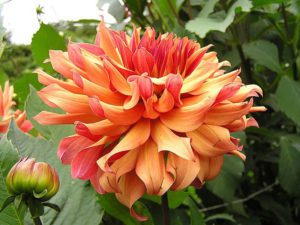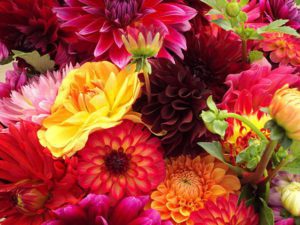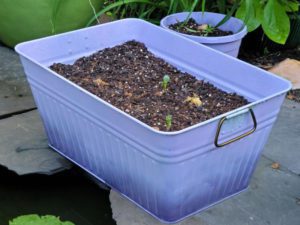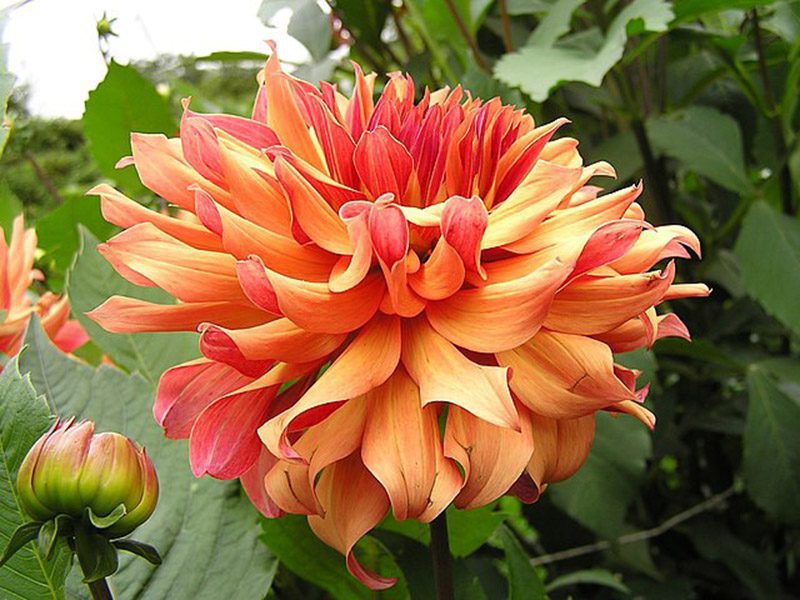
Of all the bugs that bite down here, I’ve been bitten by the Dahlia bug. They don’t do any harm, but they sure can deplete a gardening budget fast. I was completely seduced by the color photos of these gorgeous blossoms in the online and in-the-mail catalogs.
I hadn’t bothered much with Dahlias in the past. Oh sure, I start some Bishop of Llandaff seeds every few years, but honestly, they were hardly worth the effort. And I’ve always thought that those big “dinner plate” Dahlia blossoms were an affront to nature. What on earth do you dowith such blossoms?
Even though it was mid-May when I planted them (a little late to be starting Dahlia tubers or seeds), we have such a long growing season, I expect to have these late summer and fall blooming lovelies through December.
In my garden, I’m partial to “no brainer’ plants. I like plants that pretty much take care of themselves and that can be relied on to bloom without a lot of help from the gardener. Bulbs and tubers fall into that category, so I wonder why I’ve been so late coming to appreciate the variety and beauty of Dahlias. Better late than, well, you know.
This year I ordered twenty two different varieties of Dahlias. Since I waited so long to order, they were on sale (yay!). I completely renovated and weeded two beds to accommodate them. I’m not sure that so many different and colorful plants will look like a well-designed garden, but then I’m known as a “plunker” anyway. I did try to keep the color palate in the purple, mauve, pink and white spectrum, so maybe it won’t be too jarring. Well, yes, there are a few orange, red and yellow ones, too. Who could resist?
Dahlias are enthusiastic reproducers. You can start out with one tuber per plant, but by the end of the season, each plant will have a whole cluster of them. We can leave them in place down here (they have to be dug and  stored in colder zones), but we need to mark where they’re planted since the top growth completely dies down during winter. You’ll want to dig some clumps of tubers to divide and re-plant early in the spring before the top growth emerges, so you need to know where to dig. I hope to have plenty to share at the Lunch and Learn classes next year.
stored in colder zones), but we need to mark where they’re planted since the top growth completely dies down during winter. You’ll want to dig some clumps of tubers to divide and re-plant early in the spring before the top growth emerges, so you need to know where to dig. I hope to have plenty to share at the Lunch and Learn classes next year.
There are lots and lots of videos on line about growing Dahlias (and doing just about anything else, too.) For example, following video instructions, I even repaired my espresso machine. I think I inherited my “try to fix anything before calling the repair man” attitude from my son. Sometimes I’m actually successful.
Some say Dahlias as cut flowers need special attention. Cut them with stems a little longer than you want, and immediately plunge them into a metal or ceramic container filled with really hot water; between 160 and 180 degrees. Leave them until the water has cooled – at least an hour. Don’t use a glass container – it will cool too quickly. Fill a vase with tepid water and add floral powder. You can then cut them to the length you want for your arrangement. At best, they will last for 5 or 6 days. Or . . . you can just cut them in the morning like you do everything else and put them in a vase with fresh water!!
The flowers need to be at least partially open, since they do not continue opening after they’ve been cut. Buds are pretty, too, though. However, the good news is that the more you cut them, the more they bloom!
Dahlias grow well in containers, too. But have you noticed the price of planters?? Even the cheap plastic ones aren’t cheap anymore. Seeking a better solution, I ordered some rectangular galvanized tubs from Wal-Mart. Not exactly the look I want for my garden, so after I drilled holes in the bottom for drainage, I scrubbed them well with cleaning powder (to remove the zinc coating so I could paint them) and spray painted them. Instant (well, almost instant) elegance!

Update: I’m told that cleaning powder does not remove the zinc coating, so the paint will easily scratch. Remains to be seen if it will peel by itself.
And another thing. Potting soil is very dear, too. I heard from my friend, Susan Levin, that she layers several inches of twigs and garden detritus in the bottom of her large containers before she adds potting mix. You can use pieces of Styrofoam or the peanuts you seem to get in every shipping container, or even plastic bottles and soda cans. They’re lightweight and a plus for the environment to keep them out of landfills. If you use twigs or wood chips, you’ll need to add extra nitrogen when you fertilize. The wood uses it up to decompose.
I’d like to tell you about some of the cultivars I ordered, but space is limited. I doubt there are many flowers which have so many different shapes, sizes and colors of blossoms. They come in full ball, pom-pom, cactus, waterlily, anemone, peony and several other shapes. There is no pure blue, but the rest of the color spectrum is well represented.
A great bonus with Dahlias is that you need to pinch them back to create bushier plants, and these ‘pinches’ can be potted up to make new plants. Since they are really fast growing, these pinches won’t be far behind the parent plants. Of course, you could just toss them in the compost pile, but you’d need a stronger heart than mine to do it.
The ones I planted in mid-May probably won’t bloom until August, but they will continue to bloom until the first hard frost. The wait is going to seem endless, but I’ll take some photos to include in a winter column, even if it’s not about Dahlias!!
Maybe by then I’ll decide whether to call them Day-lias or Dah-lias. Depends on where you’re from, I guess. The British and a lot of southern folks call them Day-lias, (and they call Camellias, Ca-may-lias, too). Oh, well,
“Tomatoes, Tomahtoes, Let’s Call the Whole Thing Off. “








